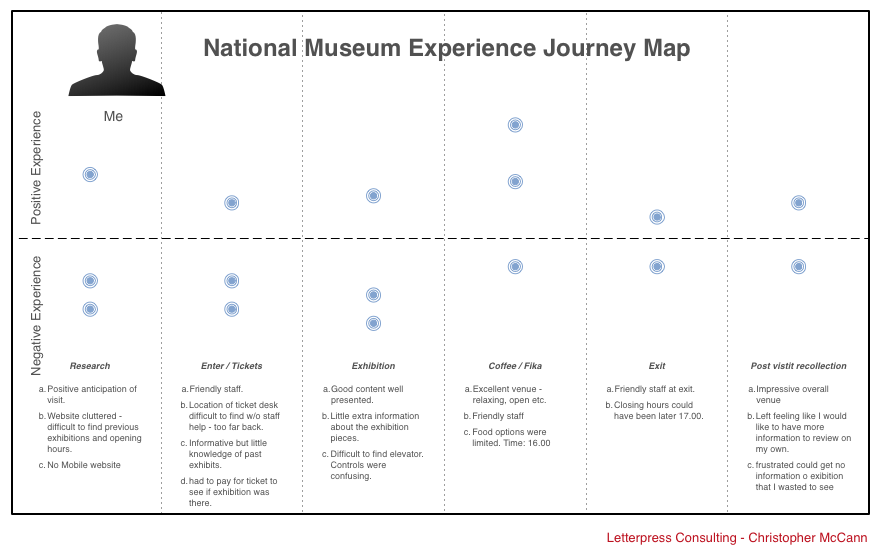Last week I met with up with my friend Kajsa Hartig that works as a Digital Navigator at Nordiska Museet in Stockholm. We had been trying to link up and visit the Swedish National Museum that is going to be remodeled and had an exhibition that highlighted a large interactive touch screen based exhibition about the remodel of the museum (we thought). We picked a date and visited the museum but sadly the exhibition was no longer being showed. This is what we deduced, since no one seemed to have any recollection of the exhibition despite me reading an article in the Swedish newspaper describing it. I found the entire visit a bit frustrating but things were saved by a good cup of coffee and chat with Kajsa. During the conversation, I explained to her I was confused over that so many museums seem to miss some basic elements when people visit them. The trend from physical ownership to access via technology is something that is increasing (cars, music etc) but yet museums have been dealing with this for years in that they display very valuable and rare objects. A key part of having access to these objects is insuring that the user experience is at a high level. We started discussing this issue further and I began to describe my recent experience working Customer Journey Mapping. I felt this technique could be very valuable in the museum world. I began sketching my experience as I prepared for todays visit and the events that followed in order to demonstrate the key points.
After the visit, I had a spare moment and sat down and refined my sketches to demonstrate how this could work.
My Experience Map
Let me start by saying this is the information for one person, me, and to get a more general view of an organization's user base one who need to conduct similar research for a larger group of persons. This group should include users that representative an accurate cross section for this organization. This would allow patterns within user groups to be established and documented using segmentation techniques or user personas.
The first diagram shows my journey divided into some basic steps. Each step refers to a mental mode I went through for the journey - research, enter/ticket, exhibition, break coffee, exit and post visit. Within each mode I then noted key experience points and if I viewed these as positive or negative.
The second image demonstrates which channels I used to interact with the museum as I passed through various mental modes. For each experience point, I also indicated my mood at the time - happy, frustrated, confused etc.
If I had to summarize the visit I would say the weak points were:
Information gathering prior to the visit via the website could have been improved. National Museums website is good, but jammed with information. Some different graphics choices (typography and white space) could have made the information more easily readable.
No Mobile website. In the beginning I was simply looking for the opening hours and I was taken to the normal website via my smart phone and forced to navigate to the 'About Us' (Om oss). There was considerable pinching and expanding involved.
The information/ ticket is almost hidden from the visitor when they enter. I found this odd since this is central for all visitors. Fortunately, there are many helpful staff that directed me to the correct area.
The personal at the information desk was very nice, but wasnt very informed of the present (outside the information brochure) exhibitions and had no idea of past exhibitions. I also thought the response 'why dont you buy a ticket and see if the exhibition is here now' was a bit poor.' I turns out this what I ended up doing, and the exhibitions wasnt there after all. I did see some other lovely artifacts !
Overall the visit to the museum was very pleasant but two areas needed additional thinking - access to information surrounding the exhibits and design of entrance/ticket areas.
Bringing the outside in using experience journey maps
Experience journey maps are a tool to help bring the outside world into an organization. They are a tool that can help bring customer stories to life. An entire story. Not just the piece one silo or function within an organization normally may encounter.
And as we map out the customer’s story, our organization’s own story becomes visible. And often what’s revealed is an incomplete fractured story.
By using experiences maps organizations can identify areas where information and technology can be introduced that improve these fractured stories. I am convinced that all museums would benefit from understanding their users better and then to match their offerings to insure a consistently positive experience for all groups.
References:
Visualizing the customer experience using customer experience journey maps
Improving the Starbucks Experience
How to create an Experience Map
Experience Mapping — a useful tool to gain customer insights
Mapping the customer experience with customer experience journey maps


